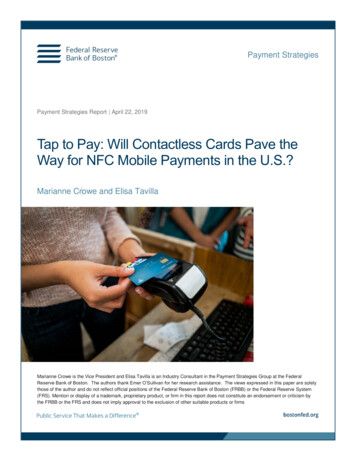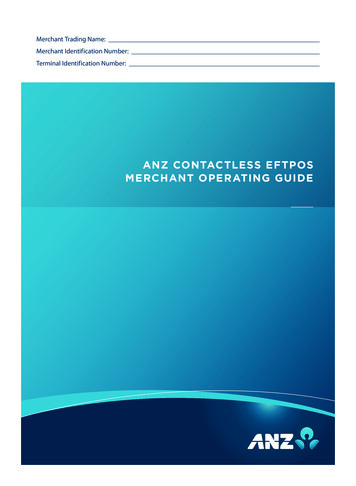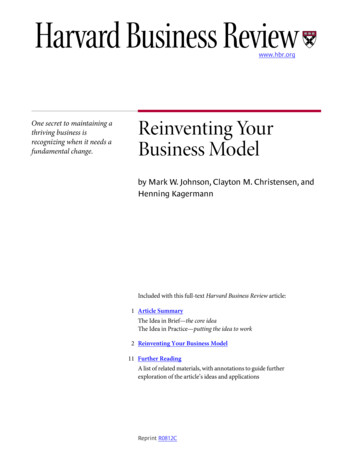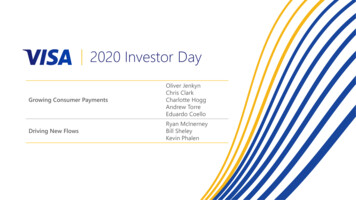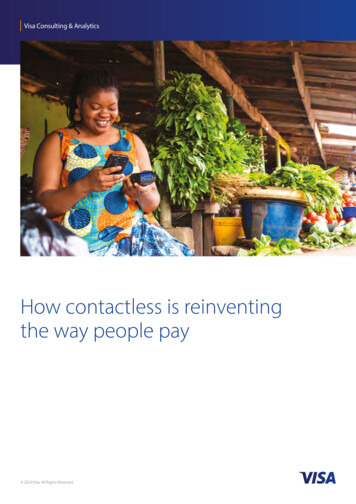
Transcription
Visa Consulting & AnalyticsHow contactless is reinventingthe way people pay 2020 Visa. All Rights Reserved.
DisclaimerCase studies, comparisons, statistics, research and recommendations are provided “AS IS” and intended for informational purposes only and should not be relied upon for operational, marketing,legal, technical, tax, fnancial or other advice. Visa Inc. neither makes any warranty or representation as to the completeness or accuracy of the information within this document, nor assumes anyliability or responsibility that may result from reliance on such information. The Information contained herein is not intended as investment or legal advice, and readers are encouraged to seekthe advice of a competent professional where such advice is required. When implementing any new strategy or practice, you should consult with your legal counsel to determine what laws andregulations may apply to your specifc circumstances. The actual costs, savings and benefts of any recommendations, programs or “best practices” may vary based upon your specifc businessneeds and program requirements. By their nature, recommendations are not guarantees of future performance or results and are subject to risks, uncertainties and assumptions that are difcultto predict or quantify. All brand names, logos and/or trademarks are the property of their respective owners, are used for identifcation purposes only, and do not necessarily imply productendorsement or afliation with Visa. 2020 Visa. All Rights Reserved.2Visa Consulting & Analytics
Contactless is a faster, easier and more secure way to payContactless is a quick, easy, and secure way to pay, which is perceptibly faster and more convenient thanpaying by cash. By the beginning of 2020, contactless accounted for more than a third of the world’s face-toface Visa transactions. In some regions, the share of contactless transactions was approaching three-quarters.In many emerging economies, contactless has also become well established, and can account for more thana third of Visa transactions.We can therefore say with real confdence that:Consequently, this paper provides: Contactless has made a sudden and significantdifference to the way that hundreds of millions ofpeople pay – in many countries around the world,contactless has quickly become deeply embedded intoeveryday payment habits, critical mass has beenachieved in many other countries, and many more arefollowing fast. A brief overview of why contactless is beingimplemented and the benefts it brings to all parties. Much has been learnt in the 15 years since contactlesswas introduced – in terms of the prerequisites forsuccessful deployments by EMVCo, the barriers to beovercome, as well as the opportunities to be pursued. An update on the current global status of contactless,and case studies regarding some of the mostsuccessful deployments. Broad suggestions of how progress can be acceleratedin new and emerging contactless markets. These learnings are valuable for the regulators, thepayments industry, the merchant community, and otherstakeholders – both in extending the reach of existingcontactless deployments and in planning futureprogrammes as the desire for cashless societies grows.3
What is contactless?Contactless is a secure, digital technology based on EMV,the global standard for smart cards.It can be deployed on payment cards, mobile phonesand many other devices such as wearables. And its aim isto make payments quicker and more convenient –while keeping them secure.Consumers pay by simply ‘tapping’ or ‘hovering’ theircard or device when prompted by the terminal.How does contactless work?Contactless payments use short-range wirelesstechnology.A tiny antenna is embedded into the card, phone orwearable device, which securely transmits paymentinformation to and from the contactless reader.For the payment to work, the card or phone must beheld within 4cm of the secure contactless reader. Itthen takes less than half a second for the reader toreceive the card details.Typically, the total transaction timeis less than 6 seconds (includingauthorization, printing and handoverof the receipt). It is thereforeperceptibly faster and easier thanpaying by cash – and is considerablymore secure.4Visa Consulting & Analytics
What is contactless?Contactless is a secure, digital technology based on EMV,the global standard for smart cards.It can be deployed on payment cards, mobile phonesand many other devices such as wearables. And its aim isto make payments quicker and more convenient –while keeping them secure.Consumers pay by simply ‘tapping’ or ‘hovering’ theircard or device when prompted by the terminal.How does contactless work?Contactless payments use short-range wirelesstechnology.A tiny antenna is embedded into the card, phone orwearable device, which securely transmits paymentinformation to and from the contactless reader.For the payment to work, the card or phone must beheld within 4cm of the secure contactless reader. It thentakes less than half a second for the reader to receivethe card details.Typically, the total transaction timeis less than 6 seconds (includingauthorization, printing and handoverof the receipt). It is thereforeperceptibly faster and easier thanpaying by cash – and is considerablymore secure.Why contactless?There are several reasons why contactless technology is strategically signifcant for the payments industry,and also for governments and regulators. These include:Out-competing cashCash still accounts for the majority of payments in many countries. Yet, as well as being inefcient toprocess and expensive to sustain, cash is inherently insecure, and its use fuels the shadow economy. Thedisplacement of cash is therefore a strategic objective for many governments, banks, payment providersand, increasingly, merchants.Contactless represents, a viable cash displacement tool – which is perceptibly faster, more secure, andmore convenient than using notes and coins.Providing a viable alternative to ‘cash-heavy’ merchantsIn those merchant environments with high payment volumes and low ticket-values, the use of cashhas been deeply entrenched. Examples include quick service restaurants, cofee bars and conveniencestores – as well as mass transit, parking and vending operators.As we discuss in this paper, contactless can bring tangible value to all merchants, but especiallycash-heavy merchants – enabling them to serve their customers more quickly, reducing line-ups,encouraging higher transaction values, and minimizing the risks and costs of cash-handling.Improving the everyday experience for consumersFor consumers, using contactless is fast, convenient and secure. It means less line-ups, faster payments,and it eliminates the need to search for coins and notes.Contactless is successful around the world because it ofers real convenience, especially for ticketingand purchases in fast-food outlets, express stores, cafes, newsagents, buses, trains, parking and vendingmachines – all the places where the cash turnover is usually high and consumers are usually in a hurry.Creating value for payment providersMost banks would agree that a more engaged customer tends to be more satisfed and also moreproftable. For example, VisaNet data from around the world suggests that a payment card is the primaryindicator of account performance, because regular users of payment cards tend to be more satisfed,more loyal, maintain higher balances, and more likely to hold additional fnancial products with theirprimary bank or fnancial institution.Contactless technology gives cardholders more reasons and more opportunities to use their cards morefrequently – consequently they are likely to be more loyal and their card is more likely to be ‘front ofwallet’, meaning that their banking relationship is more commercially viable and sustainable.4Visa Consulting & Analytics5
A safe, secure way to pay – with in-built protectionfor consumersPaving the way for many diferent form factors and innovations such as The Internetof Things (IOT)The issuance and acceptance of contactless cards opens the door to payments from many otherform factors such as smartphones and wearables. The same underlying technology is used to processtransactions, including acceptance devices and the related technical infrastructure.The potential for mobile and wearable-enabled payments is signifcant.Providing an interoperable platform for open participation, healthy competition, andregulatory oversightA clear advantage of contactless payments is that they operate as part of the four-party paymentsystem. This means that any licensed bank or payment provider can participate as either an issuer, anacquirer, or both, and many diferent technology providers and vendors can deliver solutions, whichincreases the network efects, guarantees interoperability, and enables healthy competition.As opposed to some alternative payment mechanisms, the four-party payment system is open to anynumber of participants. It is designed to enable competition, and enables governments to maintainclear regulatory oversight.Across the world, questions continue to be asked aboutthe security of contactless – and certain myths haveemerged about the level of protection provided toconsumers, and the potential for fraudsters to interceptaccount details.In fact, contactless cards use the same securetechnology as any other Visa chip card. In addition,cardholders remain in control of their cards or devicesduring the entire transaction, further reducing therisk of fraud. This makes it inherently secure. And Visaclients (such as issuing banks and acquirers) have notreported any increase in fraudulent activity as a result ofimplementing contactless since its public launch wayback in 2004.Inherent security for transactionsVisa contactless transactions are protected by very highsecurity standards and risk management processes, witha combination of technologies on the card and on theVisa processing network working together to preventfraud. For example:Together, these protections meanthat Visa contactless cards are assafe as traditional chip cards –and arguably far safer than cash.Built-in protection for consumersAll of Visa’s operating rules have been created withconsumer protection in mind.The specifcs of consumer liability may difer slightlyfrom bank-to-bank or provider-to-provider. But, whenthey participate in the Visa system, all clients agreeto a baseline level of consumer protection (such asprotection from fraud and the right of repudiation)which often goes well beyond prevailing nationalregulatory requirements. Contactless uses highly secure EMV technology andstandardized encryption technology. The payment must be prompted by the merchant,and the device must be less than 4cm away from theterminal – there is a very short read range.Bringing increased security to everyday paymentsAll contactless transactions are protected by the same secure encryption technology as any type of chiptransaction. Several additional safety measures are in-built. With mobile contactless payments like (ApplePay and Android Pay), technologies like tokenization and biometrics can bring a further layer of security.Because, the card or device doesn’t need to leave the consumer’s hand there is no scope for additionalcard details (such as the security code or CVV) to be compromised. And, of course, for consumers andmerchants alike, contactless is far safer than using cash.Although there are some common myths and misunderstandings about the theoretical risks ofcontactless, the technology is in fact highly secure. An important part of the global success ofcontactless is the protection it brings to every party – consumer, merchant, acquirer, and issuer.6Visa Consulting & Analytics Use of strong cryptographic keys and techniques onevery transaction – each card has its own unique builtin secret “key” which is used to generate cryptogramsthat uniquely identify each transaction, no two cardsshare the same key, and the key is never transmitted. At the systems level, the Visa payment network canautomatically detect and reject any attempt to use thesame payment information more than once. Even if a criminal somehow manages to “read” acontactless transaction, any information they obtaincannot be used to make a fraudulent contactlesstransaction, nor can it be used to make a workingcounterfeit chip card.7
A safe, secure way to pay – with in-built protectionfor consumersPaving the way for many diferent form factors and innovations such as The Internetof Things (IOT)The issuance and acceptance of contactless cards opens the door to payments from many otherform factors such as smartphones and wearables. The same underlying technology is used to processtransactions, including acceptance devices and the related technical infrastructure.The potential for mobile and wearable-enabled payments is signifcant.Providing an interoperable platform for open participation, healthy competition, andregulatory oversightA clear advantage of contactless payments is that they operate as part of the four-party paymentsystem. This means that any licensed bank or payment provider can participate as either an issuer, anacquirer, or both, and many diferent technology providers and vendors can deliver solutions, whichincreases the network efects, guarantees interoperability, and enables healthy competition.As opposed to some alternative payment mechanisms, the four-party payment system is open to anynumber of participants. It is designed to enable competition, and enables governments to maintainclear regulatory oversight.Across the world, questions continue to be asked aboutthe security of contactless – and certain myths haveemerged about the level of protection provided toconsumers, and the potential for fraudsters to interceptaccount details.In fact, contactless cards use the same securetechnology as any other Visa chip card. In addition,cardholders remain in control of their cards or devicesduring the entire transaction, further reducing therisk of fraud. This makes it inherently secure. And Visaclients (such as issuing banks and acquirers) have notreported any increase in fraudulent activity as a result ofimplementing contactless since its public launch wayback in 2004.Inherent security for transactionsVisa contactless transactions are protected by very highsecurity standards and risk management processes, witha combination of technologies on the card and on theVisa processing network working together to preventfraud. For example:Together, these protections meanthat Visa contactless cards are assafe as traditional chip cards –and arguably far safer than cash.Built-in protection for consumersAll of Visa’s operating rules have been created withconsumer protection in mind.The specifcs of consumer liability may difer slightlyfrom bank-to-bank or provider-to-provider. But, whenthey participate in the Visa system, all clients agreeto a baseline level of consumer protection (such asprotection from fraud and the right of repudiation)which often goes well beyond prevailing nationalregulatory requirements. Contactless uses highly secure EMV technology andstandardized encryption technology. The payment must be prompted by the merchant,and the device must be less than 4cm away from theterminal – there is a very short read range.Bringing increased security to everyday paymentsAll contactless transactions are protected by the same secure encryption technology as any type of chiptransaction. Several additional safety measures are in-built. With mobile contactless payments like (ApplePay and Android Pay), technologies like tokenization and biometrics can bring a further layer of security.Because, the card or device doesn’t need to leave the consumer’s hand there is no scope for additionalcard details (such as the security code or CVV) to be compromised. And, of course, for consumers andmerchants alike, contactless is far safer than using cash.Although there are some common myths and misunderstandings about the theoretical risks ofcontactless, the technology is in fact highly secure. An important part of the global success ofcontactless is the protection it brings to every party – consumer, merchant, acquirer, and issuer.6Visa Consulting & Analytics Use of strong cryptographic keys and techniques onevery transaction – each card has its own unique builtin secret “key” which is used to generate cryptogramsthat uniquely identify each transaction, no two cardsshare the same key, and the key is never transmitted. At the systems level, the Visa payment network canautomatically detect and reject any attempt to use thesame payment information more than once. Even if a criminal somehow manages to “read” acontactless transaction, any information they obtaincannot be used to make a fraudulent contactlesstransaction, nor can it be used to make a workingcounterfeit chip card.7
Addressing those nagging doubts about riskEven in countries where the use of contactless is well-established, there continue to be some commonmyths and misunderstandings over risk. In the UK, for example, where the use of contactless is deeplyembedded, 55% of consumer still express concerns about its security and almost a third say they are soconcerned that it puts them off using contactless at all.1So, as with any implementation program, it is important to address these head-on.Some of the most frequent include:Could I be debited twice if I have more than onecontactless card?Could a fraudster use a reader to steal mycard details?Cardholders are often concerned that their accountcould be debited more than once for the sametransaction. This can’t happen, because contactlessreaders are specifcally designed to communicate withonly one card and perform only one transaction at atime. If the reader identifes more than one contactlesscard in your wallet or purse, you will be asked to selectone card to pay. A single transaction must be completed,or cancelled, before a second payment can be initiated.Theoretically, it may be possible (but highly unlikely)for a fraudster to intercept some card details usingcontactless. But, they wouldn’t bother. Because, from afraudster’s perspective, the card details are incomplete.There’s not enough data transmitted to attempt to makea fraudulent transaction (for example, there’s no securitycode or CVV2). And there’s certainly not enough tomake a functioning counterfeit card.Could I unknowingly have made a purchase ifI walk past the reader?Despite cardholder concerns, this is not possible. Thecard has to be waived within 4cm of the card readerfor more than half a second and the retailer must havefrst entered the amount for you to approve. Terminalscan only process one payment transaction at a time,therefore reducing transaction errors.1What if my card is stolen? Would a fraudster beable make any number of contactlesstransactions?If your card is stolen, you should report it as soon aspossible, so that your bank can prevent any furthertransactions from being authorized. But, don’t worry,you will be protected. Contactless technology has manybuilt-in protections to guard against the lossor theft of your card (as a consumer, you should ask yourbank for details).MoneySavingExpert.com. 2018. Future Thinking And Equifax.Available at: r-data/8Visa Consulting & Analytics
The state of play globallyAs of the start of 2020, one-in-every-three point of saletransactions that runs over Visa’s network is contactless,versus one-in-every-four at the start of 2019.There are almost 50 countries,where contactless paymentsrepresent at least a third of allface-to-face transactions.Another important point to make is the diversenature of the countries that have been mostsuccessful in deploying contactless. There is little tounite the 21 countries with the highest levels ofcontactless penetration.The list includes: Countries with advanced, emerging anddeveloping economies Countries located in Europe, North America,South America and AsiaAnd, according to Juniper research, the total market forcontactless (comprising all of the global paymentschemes), is set to grow at a compound annual growthrate of 34% through to 2023.2 Countries that, geographically, are both smalland largeIt should be noted that the global figures are distortedby the fact that the US market is lagging behind much ofthe world. If the US market is removed from the picture,the figures are even more impressive – with contactlesstransactions accounting for more than a half (54.5%) ofall Visa face-to-face transactions.3Also, the story is much bigger than just cards, becausemobile phones account for a large and growingproportion of contactless transactions. As of November2019, 19% of all contactless transactions took place on amobile phone, rising to above a quarter in severalcountries. This was up from 13% a year previously. Countries that are both densely populated andsparsely populatedHowever, we would argue that these 21 countriesdo all share a common characteristic ordenominator: they are home to a paymentsindustry (and usually a regulator) that is collectivelycommitted to displacing cash. They haveunderstood the need for action and readinessamong issuers, acquirers, and merchants. Theyhave generally been active in articulating thebenefits of contactless to all parties. And they havetaken a pragmatic approach to risk management.Countries all around the world have embraced contactlessExample w osta RicaCzech RepublicGeorgiaRomaniaRussiaSaudi ArabiaThe NetherlandsUnited KingdomJuniper Research, Contactless Payments Deep Dive & Forecasting 2018-2012, June 2018.VisaNet transations December 2019.9
Some snapshots from around the world of contactlessCase Study: Costa Rica: The central bank played a pivitol role in the move to contactless.Immediate impact, helped by a strongregulatory stanceAs a contactless case study, Costa Rica may sound likean unlikely country.By the end of 2018, the country had converted 72%of its payment cards and 77% of its point-of-sale (POS)terminals to contactless, and contactless transactionsaccounted for 26% of face-to-face Visa card transactions.In most Latin American countries, the evolution tocontactless is only just getting started. However, CostaRica is well ahead of its peers. Supported by a centralbank mandate and an ambitious project to upgradethe payment system for the country’s transportationnetwork, Costa Rica began a concerted efort tomigrate to contactless in 2015.By the end of 2019, the penetration of contactlesstransactions had almost doubled to reach animpressive 49% of all face-to-face Visa transactions.This meant that Costa Rica edged ahead of Chile(which has a contactless penetration rate of 48%), torank in the global Top 20 countries with the highestlevels of Visa contactless penetration.The central bank has played a pivotal role in the story.It made the case that, if interoperable contactlesscards were adopted at scale, high levels of cashdisplacement could be achieved. It also calculatedthat, by implementing contactless payments for publictransport alone, a 30% reduction in the purchasevolume of cash could be achieved.Case Study: United Kingdom: Acceptance for the London Olympics and transit were thecatalysts for contactless becoming commonplace in just four years.A slow start, followed by a game-changing transitprogramAs the frst country to embark on a mass-market launchof contactless, things took longer to get moving.4Launched in 2007, there was little traction until 2012,when consumers were encouraged to use contactless atthe London 2012 Olympics and on the London transportnetwork. This put pressure on issuers to meet thedemand for contactless travel. By 2016, contactless hadbecome common place.Contactless cardholders are also more engagedand have signifcantly higher spend and transactionsper card:Today, 7-in-10 face-to-face Visa transactions in the UK arecontactless. With the average transaction value of contactlessdebit cards sitting at approximately 8, contactless cards areideal for everyday spend and small-ticket transactions,which has helped to displace the use of cash. For debit and prepaid cardholders, the average spendper active contactless card is 2.1 times higher, and thetotal transactions per active card is 2.5 times higher.4VisaNet Data February 2017.10In fact, as a proportion of UK retail spend, cash droppedfrom 32% to 16% between 2011 and 2019, and anestimated 3.2 million UK consumers live cashlessly(versus 2.2 million people who are cash-reliant).Visa Consulting & Analytics For credit cardholders, the average spend per activecontactless card is 1.6 times higher, and the totaltransactions per active card is 2.1 times higher.
Case Study: Canada: Segment-leading merchants and a cardholder verifcation limit of 100 CAD helped contactless become commonplace in just three years.A strong start, pushed forward by leadingretailersContactless continues to accelerate: 62% of face-to-face Visa transactions carried out inCanada in 2019 were contactlessContactless cardholders in Canada are moreengaged and have signifcantly higher spendand transactions per card: For credit cardholders, the average spend per activecontactless card is 2.8 times higher, and the totaltransactions per 4.5 times higher For debit and prepaid cardholders, the averagespend per active contactless card is 3.3 times higher,and the total transactions 5.0 times higherAdditionally, cash displacement coincided with thearrival of contactless, with Canada seeing a third fewercash transactions in 2015 than in 2008.Contactless was launched in Canada in 2010 andbecame commonplace just three years later. Thestrong start was spurred on by several segmentleading merchants adopting contactless, whichencouraged wider-scale acceptance, helped alongby a cardholder verifcation methodology (CVM)limit of CAD 100.Meanwhile, several transit deployments promise tocatalyse further growth. In May 2018, for example,Vancouver Transit Authority (Translink) launchedcontactless travel citywide, Laval followed in February2019, and Toronto is set to follow in 2020.Today over 80% of merchant point-of-sale devices,including at grocery stores, pharmacies and gasstations, are contactless enabled.11
Case Study: Russia: The introduction of the Pays, means contactless payments accountsfor more than 80% of all Visa face-to-face transactions in Russia.Rapid migration, with a high proportion ofmobile paymentsBetween 2010 and 2013, Visa worked with manyof the county’s largest retailers to encourageand enable contactless acceptance. Meanwhile,despite a shortage of certifed contactless cardmanufacturers in the local market, Visa also workedwith those issuers representing 90% of paymentvolumes to commit to contactless.The frst retailer to commit wholeheartedly tocontactless was Auchan. In 2013, it enabledPIN-free contactless acceptance for transactionsof less than RUR1,000 (approximately US 30 at thetime). And, based on the benefts Auchan expectedfrom contactless, many other large retailers soonfollowed suit.Amid growing enthusiasm for contactless amongretailers, Russia’s largest Visa customer, Sberbankinvested in an infrastructure upgrade.12Visa Consulting & AnalyticsBetween 2014 and 2015 the bank migrated its entirenetwork of around 1 million point of sale terminals(representing some 50% of the entire market) tocontactless. Meanwhile, INPAS, a key vendor ofacceptance devices, phased out the supply of noncontactless terminals.In 2016 Sberbank, decided to complement itssuccessful contactless card programmes with theintroduction of Apple Pay. And, by 2019, the majority ofRussian Visa issuers had introduced Apple Pay and/orGoogle Pay.As of the start of 2020: 81% of all face-to-face Visa transactions in Russiawere contactless 22% of all face-to-face transactions in Russia weremobile phone-initiated
Case Study: Australia: Once several segment-leading merchants upgraded their acceptanceinfrastructure, contactless became commonplace in just four years.A faltering start, followed by strong retailsupportFirst introduced in 2006, contactless had a relativelyslow start.The technology arrived just as the country’smost infuential merchants had invested in EMVterminals. Consequentially the merchants hadto choose whether to upgrade their terminalsand write-of the additional investment, or delayimplementation.Ultimately, in 2009, several segment-leadingmerchants, including Woolworths and Coles (thetwo largest supermarkets), decided to upgrade,having calculated that the likely value of contactlessacceptance outweighed the undepreciated valueof their EMV terminals. This meant it only took fouryears for contactless to become commonplace,as big businesses accepting contactless droveacceptance downstream to small businesses.Data from the Reserve Bank of Australia shows that,by 2019, the number of ATM withdrawals was 35%below its 2008 peak, and had fallen by an average ofaround 5% per year over the previous fve years.5Today, almost all face-to-face transactions inAustralia are contactless (96% by the end of 2019).Meanwhile, contactless-active cardholders are moreengaged and have signifcantly higher spend andtransactions per card: For credit cardholders, the average spend peractive contactless card is 3.4 times higher, the totaltransactions 6.1 times higher For debit and prepaid cardholders, the averagespend per active contactless card is 2.4 timeshigher, and the total transactions 5.0 times higher5Reserve Bank of Australia, New Payments Insights from the Updated Retail Payment Statistics Collection, March 2019.13
Case Study: Georgia: Banks and Merchants have embraced contactless. Today almost 100%of all face-to-face Visa transactions are contactless.Leadi
Consumers pay by simply 'tapping' or 'hovering' their card or device when prompted by the terminal. How does contactless work? Contactless payments use short-range wireless technology. A tiny antenna is embedded into the card, phone or wearable device, which securely transmits payment information to and from the contactless reader.


